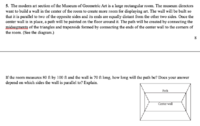You are using an out of date browser. It may not display this or other websites correctly.
You should upgrade or use an alternative browser.
You should upgrade or use an alternative browser.
Geometry Problem Involving Mid-segments (Urgent Help Please)
- Thread starter s10007
- Start date
Dr.Peterson
Elite Member
- Joined
- Nov 12, 2017
- Messages
- 16,865
Please show your work for the numerical question, and then we can help you generalize it.
Essentially, though, you will be doing the same work with letters replacing the numbers, so the answer will be an expression.
Essentially, though, you will be doing the same work with letters replacing the numbers, so the answer will be an expression.
For the numerical question, my answer would be 250. This is because, from the triangle midsegment conjecture, I know the widths of the path will be half of 80, so 40 and 40. From the trapezoid midsegment conjecture the length of the path will be the average of the bases of the trapezoid, so (100+70)/2 or 85 and 85. Thus 85+85+40+40 would equal 250 ft.
HallsofIvy
Elite Member
- Joined
- Jan 27, 2012
- Messages
- 7,760
Here's how I would do this- probably more "sophisticated" than necessary.
Set up a coordinate system with x- axis along the center wall and origin in the middle of that center wall.
The walls of the room will be at x= -50, x= 50, y= -40, and y= 40. The four corners of the wall are at (-50, 40), (-50, -40), (50, -40) and (50, 40). The ends of the center wall are at (-35, 0) and (35, 0).
The "path" around the room makes turns at the midpoint of the line from (35, 0) TO (50, 40), the midpoint or the line from (-35, 0) to (-50, 40), the midpoint of the line from (-35, 0) to (-50, -40), and the midpoint of the line from (35, 0) to (50, -40), Those midpoints are (42.5, 20), (-42.5, 20), (-42.5, -20), and (42.5, -20). The distance from (42.5, 20) to (-42.5, 20) is 85 and the distance from (-42.5, 20) to (-42.5, -20) is 40. The other two distances are, of course, the same so the length of the circuit is 2(85+ 40)= 2(125)= 250 ft. just as you say!
Set up a coordinate system with x- axis along the center wall and origin in the middle of that center wall.
The walls of the room will be at x= -50, x= 50, y= -40, and y= 40. The four corners of the wall are at (-50, 40), (-50, -40), (50, -40) and (50, 40). The ends of the center wall are at (-35, 0) and (35, 0).
The "path" around the room makes turns at the midpoint of the line from (35, 0) TO (50, 40), the midpoint or the line from (-35, 0) to (-50, 40), the midpoint of the line from (-35, 0) to (-50, -40), and the midpoint of the line from (35, 0) to (50, -40), Those midpoints are (42.5, 20), (-42.5, 20), (-42.5, -20), and (42.5, -20). The distance from (42.5, 20) to (-42.5, 20) is 85 and the distance from (-42.5, 20) to (-42.5, -20) is 40. The other two distances are, of course, the same so the length of the circuit is 2(85+ 40)= 2(125)= 250 ft. just as you say!
Dr.Peterson
Elite Member
- Joined
- Nov 12, 2017
- Messages
- 16,865
Good. Now suppose that the 80 and 100 were switched, and answer the question, "Does your answer depend on which sides the wall is parallel to?"For the numerical question, my answer would be 250. This is because, from the triangle midsegment conjecture, I know the widths of the path will be half of 80, so 40 and 40. From the trapezoid midsegment conjecture the length of the path will be the average of the bases of the trapezoid, so (100+70)/2 or 85 and 85. Thus 85+85+40+40 would equal 250 ft.
Then do the exact same work, but with the letters a, b, and x in place of the numbers 80, 100, and 50. The result is interesting, and will confirm your numerical answers.
One question from me, though: why are you using "conjectures"? That means statements that have been guessed but not proved. I would think that you would have seen them proved before you started using them to solve problems! Were they proved, making them theorems, but you forgot to use their new names?
Dr.Peterson
Elite Member
- Joined
- Nov 12, 2017
- Messages
- 16,865
Again, do the same work you did, using variables rather than numbers! You said this:
So do this:For the numerical question, my answer would be 250. This is because, from the triangle midsegment conjecture, I know the widths of the path will be half of 80, so 40 and 40. From the trapezoid midsegment conjecture the length of the path will be the average of the bases of the trapezoid, so (100+70)/2 or 85 and 85. Thus 85+85+40+40 would equal 250 ft.
I shouldn't need to say this over and over.From the triangle midsegment [theorem], I know the widths of the path will be half of a, so __ and __. From the trapezoid midsegment [theorem] the length of the path will be the average of the bases of the trapezoid, so (b+x)/2 or __ and __. ...

